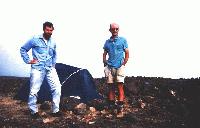
Brother Silvino and Franco Andreone
at Ilheu Razo.
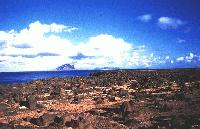
Landscape of Ilheu Razo with
evidente in the back Ilheu Branco,
Sao Vicente and Santa Luzia. Razo
and Branco are the islets where for
certain Macroscincus coctei lived
until the end of the last
century
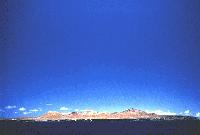
Landscape of Ilheu Razo.
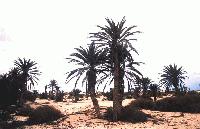
Landscape of Boa Vista with the
palms Phoenix atlantica.
In this island Leonardo Fea staied
for a certain period and made
interesting observations.
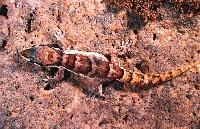
Hemidactylus bouvieri is one of the most
interesting geckoes. The specimen
has been photographed at Sao Vicente.
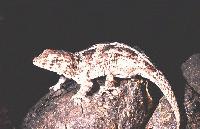
Tarentola gigas.
This partly terrestrial large gecko
lives only at Ilheu Razo and Ilheu
Branco.
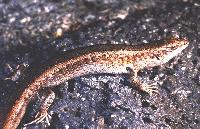
Mabuya stangeri.
Specimen from Ilheu Razo. Mabuyas
belong to the same family of
Macroscincus coctei (Scincidae),
but they are clearly smaller.

Alcatraz, Sula leucogaster.
At Ilheu Razo there is an imponent
colony of this interesting and
wonderful seabird.
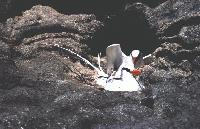
Phaethon aethereus.
This beautiful seabird nests at
Ilheu Razo.
|
In 1898 the naturalist Leonardo Fea, born in Turin, and Assistant at the Natural History Museum in Genoa, visited the Cape Verde Islands. This fellow, zoologist and painter, was enthusiast in exploring far and little known countries. The Cape Verde Islands, at about 600 Km from Senegal, were for him a sort of "quiet travel", since it already made an expedition to Birmany (Myanmar). When he arrived at the vulcanic islands of Cape Verde, affected by terrible periods of drought, he made interesting collectings, as witnessed in his "lettere" [letters] published on the Bollettino della Società Geografica Italiana, and illustrated by his wonderful incisions. Yet used to the faunistic richness of Birmany Fea felt "disappointed" by the "poorness" of Cape Verde. More or less the same feeling was expressed by another naturalist, Charles Darwin, who stopped in 1832 at Cape Verde, just the time to notice that these islands were just the contrary of Galapagos! Anyhow, Fea found "some" animals and plants too, among which some new species: his material is now conserved in Genoa. Among the most interesting animals we quote remind some specimens of the giant skink (locally known as "lagarto"), Macroscincus coctei. Fea was possibly the last naturalist who observed this presumably extinct species as alive. A very large skink, its length reaching 60 cm, the "lagarto" lived at least in two islets of the archipelago, Ilhéu Razo and Ilhéu Branco, which were perhaps the last refuges within a larger distribution area. Fea remained at Razo for twelve days, and captured some specimens of Lagarto, which now are conserved in Genoa. Fea was not the first Italian naturalist in being interested to M. coctei. Yet some years before, in 1891, the Turinese herpetologist Mario Giacinto Peracca, got about forty live specimens. He took these animals in the terraria he built up in his "estate" in Chivasso town, next to Turin. The "rediscovery" of 26 of these specimens now at the Museo Regionale di Scienze Naturali di Torino (perhaps the greatest series of the World) "pushed" me to make a new expedition at Cape Verde, just one century after that of Fea (1898-1998). Like Fea I visited the islands of Fogo, São Vicente, São Nicolau, Boa Vista and the Ilhéu Razo. My hope was to find traces of the giant skink, or, live animals. Unluckily I was not able to reach this result: it seems that, at least at Razo, the skink is extinct, or at least greatly lowered in number. Which may be the causes of this phenomenon? Most likely an animal of such a size, and relatively "confident" due to its life in islands without natural predators, became an easy victim of fishermen who, still today, go regularly on these islets looking for any kind of food sources. And in fact, from the beginning of the arrival of human populations at Cape Verde, about 500 years ago, Man contributed to modify the natural habitat, by introducing "exotic" animals, such as goats, donkeys, cats and dogs (and the always present rats). These animals were among the causes of lowering of many species in several parts of the World. At Cape Verde a bird species, the "alcatraz" Sula dactylatra is now extinct, while others, as the "cagarra" (Calonectris edwardsii), is systematically hunted each year and its new-borns captured in thousands for being cooked during a local ceremony. Therefore the giant skink was perhaps a good source of food. But anyway I found several other species of reptiles: almost every island of Cape Verde is inhabited by a species or subspecies of Mabuya, Tarentola or Hemidactylus. The isolation and the different environmental conditions originated an interesting adaptive radiation. At Ilhéu Razo I found another interesting endemism, a gecko if the genus Tarentola, which, for its size (up to 30 cm) has been, correctly, named gigas. This remarkable reptile is present only at Razo and Branco. Less "interesting" for the local populations it has been able to escape, for the moment, to the extinction.
Franco Andreone
|